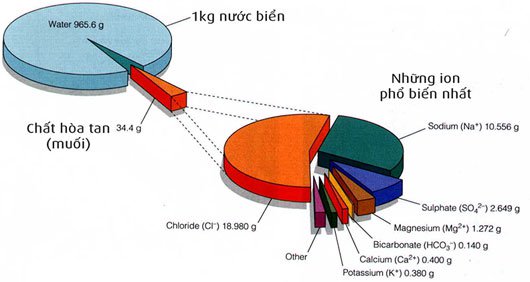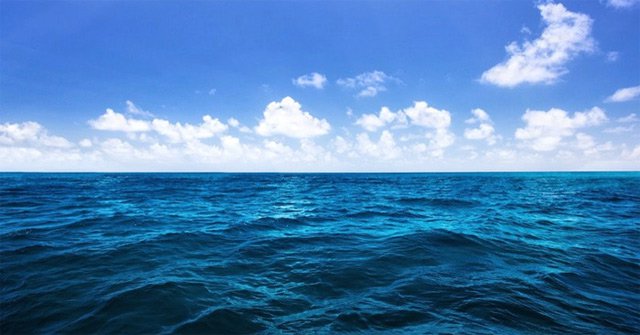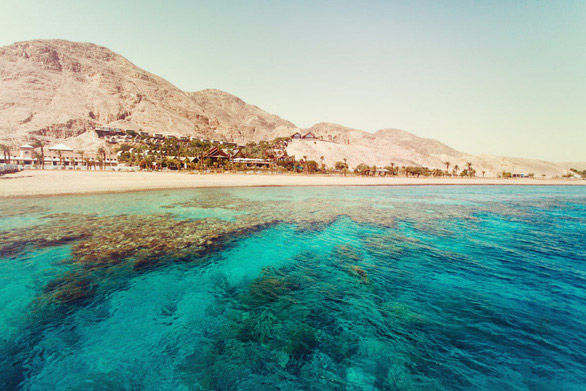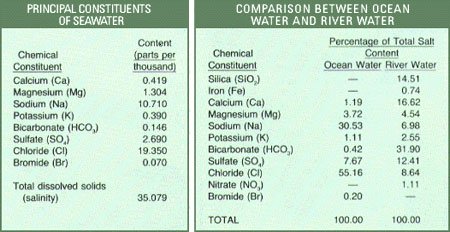Why is seawater salty?
All the water on our planet, from rainwater, pond water, sea water . contains chemical compounds called 'salt' by scientists. However, only seawater is always salty, but others do not. Why is there such a difference, find out through the article below.
The origin of the ocean
The Earth consists of 5 oceans: the Pacific Ocean, the Atlantic Ocean, the Indian Ocean, the Arctic Ocean and the Antarctic Sea. According to scientists' estimates based on ancient biological fossils found on the sea floor, the ocean is about 500 million years old.

Regarding the origin of the great king, many scientists have come up with different theories but no theory can explain all aspects of the problem.
Among them, the hypothesis that both the atmosphere and the ocean are accumulated gradually from the time of geological tectonic through the process of "gas" of the Earth received the most agreement of scientists. .
According to this theory, steam and other gases escaped from Earth's molten magma after rising high, cooled to cloud cover above. As the Earth cools below the boiling point of water, rain begins to appear and lasts for centuries to come. This rainfall covers almost the entire surface of the Earth, and creates the first primitive ocean. At this time, thanks to gravity, the water is retained, not falling off the Earth.
The origin of salt
Seawater is a complex mixture of decomposing marine organisms and mineral salts. The magma on the Earth's crust is cooled by weathering and dishwashing. When mountains are formed, minerals from the land are swept by rainwater and streams to the sea and accumulate into a large amount like today.
Stones and sediments beneath the seabed also contribute to the creation of some salts in the ocean. In addition, salt in the ocean comes from the types of solids and gases inside the Earth's heart escaping through craters in the ocean.
Large amounts of fresh water from the rivers flow into the sea, so why is seawater not diluted by freshwater?
Day and night, the huge amount of fresh water from the big rivers in the world such as Amazon, Mississippi, and Mekong, . always poured into the Pacific and Atlantic oceans . So why is the sea water still salty but not made? diluted? The reason is that salt is just one of the elements that make up the salty taste of the ocean.
The ancient sea contained only a small amount of salt, not salty as it is today. But about a hundred million years ago, the water created from the first rains poured down the young Earth broke the geological layers and dragged the minerals into the sea. This makes the sea water more salty. It is estimated that every year rivers and streams from the US flowing into the sea carry 225 million tons of dissolved solids and 523 million tons of sediments. If you count all the rivers on Earth, the amount of mineral salts pouring into the sea each year reaches 4 billion tons.
Let us know that, under the effect of heat from the Sun, almost pure steam in the sea rises high, but mineral salts still remain in the sea. This steam is carried by the winds to other places. Water vapor will condense when cold air is high and falls to the ground to form rain. Rainfall on land will converge on streams and rivers and eventually flow into the sea. This amount of fresh water will dissolve the salt in the sea, making the salt water salty. This cycle keeps going on like that.

Water cycle.
Composition of seawater
After years of research, scientists have not been able to fully understand the chemical composition of seawater. The main reason is because of the large size of the Ocean, which accounts for 70% of the Earth's surface, the marine environment has a system of extremely complex chemical compounds that some of them continually change. according to the period of time.

Composition of seawater.
Currently, scientists have only discovered 72 chemical elements in seawater, a number so small compared to the amount of compounds that actually exist in the ocean. Some scientists believe that all natural elements of the Earth exist in seawater, even when they are combined in both dissolved forms, or precipitate into sediments. standing in the seabed. Even when precipitated, under the influence of continuous processes in the marine environment these compounds are still capable of changing the chemical composition.
How salty is sea water?
According to chemists, there are more than 50 million tons of substances dissolved in the oceans on Earth. If it is possible to remove salt in seawater and bring it to the surface and spread it across continents, it will create a layer of 152m thick, equivalent to a 40-storey building today.
Of the 28 liters of seawater containing about 1 kg of salt, according to researchers' calculations, seawater is about 220 times more salty than freshwater in the lake.

However, the salinity of the seawater changes in different areas on Earth, it depends on factors such as evaporation level, amount of purchase, level of melting ice, water flow from rivers and streams, Snow, wind, wave movement into ocean currents.
The most salty seawater .
The sea area with the most salinity belongs to the Red Sea and the Persian Gulf area, the two areas with the highest evaporation rate of seawater, with 40 o / oo, the thousandth unit (o / oo) to measure about salinity.

Red Sea is the most salty sea in the world.
Compared to large oceans, the ocean has the largest salinity level of the Atlantic Ocean, with an average salinity of about 37.9 o / oo. In the North Atlantic Ocean, the Sargasso Sea is the region with the highest salinity because the temperature in this area is quite high and lies far from the mainland so it does not receive fresh water from rivers and streams.
Seawater has the lowest salinity of the Arctic and Antarctic waters, 2 areas with low temperatures, continuous rain and melting ice.
Coastal coves such as the Baltic Sea (salinity of 5 to 15 o / oo), Black Sea (salinity below 20 o / oo) . have lower salinity than average because of supplementing water sources New sweet mass of several billion tons per day.
The salinity of the seas along the coastal regions of the countries also varies according to geographical location and time of year.
In general, the average salinity of seawater across the Earth is about 35 o / oo. This is the result estimated by scientist William Dittmar in 1884, after analyzing 77 seawater samples in different parts of the world.
Composition results of 77 seawater samples.

How are the composition of river and sea water different?
William Dittmar's analysis shows that seawater includes many different compounds. Sodium and chlorine (combined into NaCl) are the main factors that make up the salty taste of seawater, accounting for 85% of seawater solutes. In the ocean, the amount of Chlorine is 46 times that of Calcium.
In the river water contains a quantity of silicate and iron compounds, in the sea water is not available. In addition, 50% of dissolved solids contained in river water are Calcium Bicarbonate, 2% less than seawater.
The proportion of major constituents of seawater is almost constant, NaCl, Magnesium, Sulfate, Calcium and Potassium account for 99% of water-soluble solid compounds, although the salinity and total salt content of seawater differ. Between the world.
Other non-common elements, such as aluminum, copper, tin, . dissolved gases such as oxygen, CO2, nitrogen, have a difference between different sea waters.
You should read it
- Water glasses that you drink every day can contain many harmful substances such as chlorine, pesticides, arsenic ...
- Create sponge that can boil water
- About 90% of Vietnamese eat excess salt, 4 hazards when Vietnamese eat too salty
- It turns out this is the reason why seawater is often blue but the waves are white
- Instructions for using water swab machine
- Top 4 best selling hot and cold water plants today
- Top 5 best water toothpick machines today
- Water will become 'poison' if taken at 5 times later
May be interested
- After the river flows into the sea, where did the freshwater fish go?
 the average salinity in seawater is 35‰ so it is not drinkable without too much treatment and freshwater fish cannot survive in the ocean. so, where did the freshwater fish go or are they going to die?
the average salinity in seawater is 35‰ so it is not drinkable without too much treatment and freshwater fish cannot survive in the ocean. so, where did the freshwater fish go or are they going to die? - Rising CO2 is also causing trouble for freshwater environment
 as the amount of carbon dioxide (co2) in the atmosphere increases, more co2 is absorbed into the seawater. as a result, the world's oceans have developed many acids over a long period of time, causing a range of survival problems for marine animals and ecosystems. now, the researchers report in current biology that they have released the grave
as the amount of carbon dioxide (co2) in the atmosphere increases, more co2 is absorbed into the seawater. as a result, the world's oceans have developed many acids over a long period of time, causing a range of survival problems for marine animals and ecosystems. now, the researchers report in current biology that they have released the grave - These are the reasons you should cut down on salt in your diet
 have you ever thought about eating food, food consumed daily without salt or not? the answer is no, right? you can eat food without spices, but can't help without salt. salt has become an essential part of our daily diet. but in some situations when the body speaks, you will have to cut down on the daily salt intake to avoid 'risk' of threatening your health.
have you ever thought about eating food, food consumed daily without salt or not? the answer is no, right? you can eat food without spices, but can't help without salt. salt has become an essential part of our daily diet. but in some situations when the body speaks, you will have to cut down on the daily salt intake to avoid 'risk' of threatening your health. - For the first time successfully implementing underwater quantum teleportation, China took the lead in the quantum communication race
 in the recent test, chinese researchers succeeded in sending quantum information (also known as quantum displacement) between two tangled particles through seawater.
in the recent test, chinese researchers succeeded in sending quantum information (also known as quantum displacement) between two tangled particles through seawater. - The following 5 inventions can 'save' Earth and humanity
 in order to save the earth as well as to ensure the future of all humanity against the ever-increasing negative impacts in both quantity and level, scientists around the world are constantly studying to make inventions. useful.
in order to save the earth as well as to ensure the future of all humanity against the ever-increasing negative impacts in both quantity and level, scientists around the world are constantly studying to make inventions. useful. - The most special fish on the planet has pale green flesh like in fiction films
 particularly rare fish have turquoise flesh like seawater that actually exists outside the ocean, they are called lingcod - or cotton grouper.
particularly rare fish have turquoise flesh like seawater that actually exists outside the ocean, they are called lingcod - or cotton grouper. - How to make Doremon donuts (Dorayaki cake) with convenient mixes
 learn how to make doremon donut made with pre-mixed dough with 3 delicious ingredients.
learn how to make doremon donut made with pre-mixed dough with 3 delicious ingredients. - Ships traveling around the world for 6 years do not need fuel
 during the day, ships use solar energy and wind power, and by night the vessel operates on energy, powered by hydrogen fuel generated by seawater electrolysis.
during the day, ships use solar energy and wind power, and by night the vessel operates on energy, powered by hydrogen fuel generated by seawater electrolysis. - Can Pokemon Go be played on a computer? The answer is yes!
 by software emulation and additional software to support positioning, we can completely play pokemon go right on the computer, comfortable catching pokemon without worrying about running out of battery when playing as on the phone.
by software emulation and additional software to support positioning, we can completely play pokemon go right on the computer, comfortable catching pokemon without worrying about running out of battery when playing as on the phone. - Summary - How to play Pokemon GO, virtual reality game catch Pokemon on smartphone
 pokemon go game (styled, raising and training virtual animals) has become popular, the online community with new movements also immediately responded to this mobile game in the direction positive direction
pokemon go game (styled, raising and training virtual animals) has become popular, the online community with new movements also immediately responded to this mobile game in the direction positive direction










 Scientists have found a way to boil water with sound
Scientists have found a way to boil water with sound What is hypoglycemia? Is hypoglycemia dangerous?
What is hypoglycemia? Is hypoglycemia dangerous? What is blood pressure? What is normal blood pressure?
What is blood pressure? What is normal blood pressure? 11 beautiful flowers contain deadly poisonous drama
11 beautiful flowers contain deadly poisonous drama This girl was the one who used the 'capture' algorithm to capture the first black hole in history
This girl was the one who used the 'capture' algorithm to capture the first black hole in history What is halo moon, moon canopy? Why are there these two natural phenomena?
What is halo moon, moon canopy? Why are there these two natural phenomena?